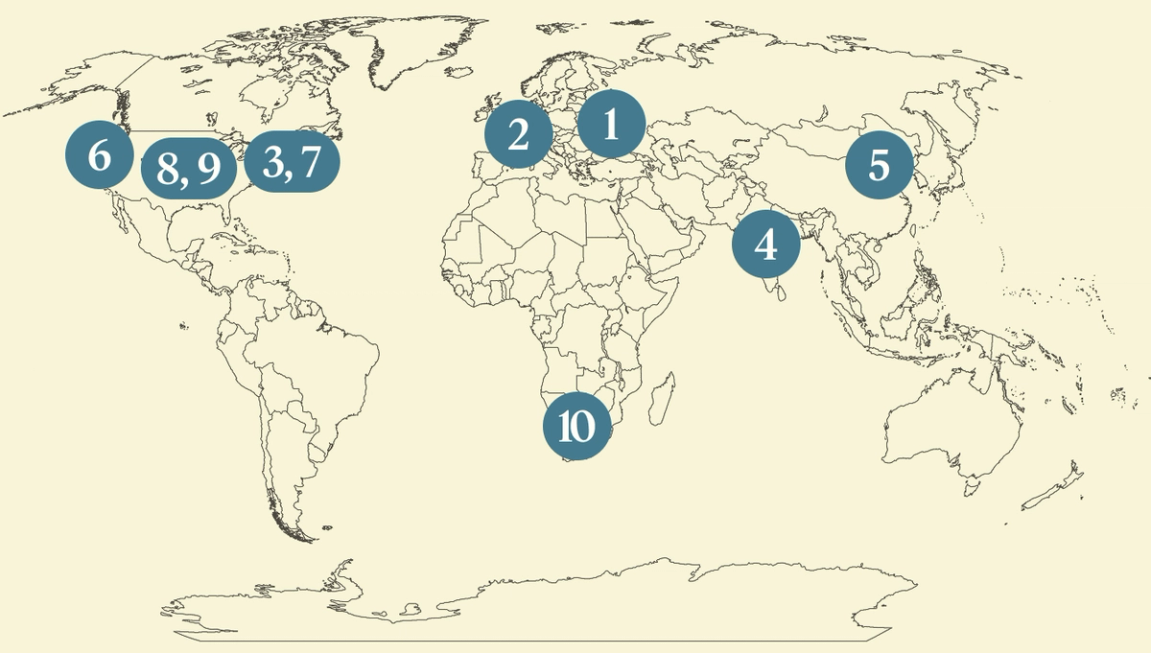| | Europe grows more hopeful about Ukraine after a call with Donald Trump, investors’ appetite for cryp͏ ͏ ͏ ͏ ͏ ͏ |
| |  | Flagship |  |
| |
|
The World Today |  - Trump-EU plan for Putin
- US slashes rights report
- Trump as America’s CEO
- Flattery as diplomacy
- China’s rare-earth challenge
- Nuclear energy’s US moment
- Bullish on Bullish
- Palantir’s mystery
- Americans drink less
- Radioactive rhino horns
 The effort to keep some of Frank Lloyd Wright’s artifacts off the private market. |
|
Europe hopeful after Trump call |
 Anatolii Stepanov/Reuters Anatolii Stepanov/ReutersUS President Donald Trump threatened “very severe consequences” if Russia’s Vladimir Putin refuses to end the war in Ukraine when the two leaders meet on Friday. Trump’s warning Wednesday followed his call with Ukraine’s president and European officials, who said they solidified a strategy with Trump to keep Ukraine looped into peace talks, and not negotiate territorial swaps with Moscow without Kyiv’s involvement. The last-minute diplomatic frenzy reflects Europe’s worry that Putin could pull Trump into a one-sided deal. The continent’s leaders used “little psychological tricks” and flattery to close ranks with the US president, Der Spiegel wrote. But with hours to go before Trump’s meeting with Putin in Alaska, “Will he still remember the Europeans’ advice then?” |
|
US slams Europe in human rights report |
 Umit Bektas/Reuters Umit Bektas/ReutersA US State Department report on international human rights accuses democratic allies of online censorship and downplays well-documented abuses by authoritarian governments. The report, about one third the length of last year’s, said Germany suppressed speech through its social media moderation rules, while finding “no credible reports of significant human rights abuses” in El Salvador or Hungary. Critics noted that sections on corruption and LGBTQ rights had been trimmed down or removed. “Ironically, this shift in American language puts the US directly in alliance with China, whose diplomats have been campaigning for years to change the diplomatic discourse about human rights,” Anne Applebaum argued in The Atlantic. The report made no mention of China’s crackdown on peaceful assembly. |
|
Donald Trump: America’s CEO |
 Jonathan Ernst/Reuters Jonathan Ernst/ReutersUS President Donald Trump is increasingly operating as the country’s CEO, several commentators argued. His involvement in a deal around US chipmakers’ sales to China marked Trump’s latest unorthodox corporate intervention; he has also sought to exert influence over the country’s central bank and policing in Washington, DC. While traditional American conservatism favors limited government involvement, a newer strain on the right advocates for the public sector to operate more like a business. That approach carries risks, a former George W. Bush adviser warned: “[Trump] owns all of it. He doesn’t even delegate it to Cabinet secretaries that he can fire if it doesn’t go well… I would never advise a president to take ownership of so many things.” |
|
A case for India flattering Trump |
 Kevin Lamarque/Reuters Kevin Lamarque/ReutersOne way New Delhi can get back in US President Donald Trump’s good graces is by nominating him for the Nobel Peace Prize, a prominent Indian economist argued. Trump has threatened India with sky-high tariffs and penalized it for purchasing Russian oil, further straining ties with New Delhi, which was already infuriated when Trump claimed credit for ending India’s brief conflict with Pakistan. Islamabad, on the other hand, vowed to nominate Trump for the Nobel, joining a host of other world leaders who have praised him for mediating various global conflicts. “Flattery is fundamental” to appeasing the US president, Swaminathan S Anklesaria Aiyar argued in The Times of India. Case in point: Pakistan suddenly finds itself in Trump’s good books. |
|
China’s rare earth leverage could weaken |
 David Gray/Reuters David Gray/ReutersChina’s weaponization of its rare earth dominance will backfire as Western nations learn to find alternatives, The Economist argued. More than half of the world’s supply of the crucial metals is mined in China, and 90% is refined there. That chokehold has given Beijing significant leverage in its ongoing trade talks with Washington, extracting US concessions by limiting exports. But the strategy could have unintended long-term consequences, The Economist wrote, as it forces companies to “find ways around the shortage” by mining their own reserves and building their own refining technology. Australia is loaning $1 billion to a mining company to boost operations in Western Australia; the firm aims to meet “a significant proportion of Western demand” by 2030. |
|
 Diablo Canyon plant. Genaro Molina/Los Angeles Times via Getty Images Diablo Canyon plant. Genaro Molina/Los Angeles Times via Getty ImagesThe US Department of Energy on Tuesday kickstarted a pilot program to deploy small nuclear reactors across the country. Eleven projects were selected, with the aim of getting three to be operational in less than a year, Reuters reported, and wider commercial deployment expected by 2030. Microreactors can fit in a truck trailer and generate about a thousandth of the energy of a major legacy nuclear plant. Nuclear power is having a moment in the US, embraced by pop culture and politics, The Wall Street Journal wrote, and fueled by Big Tech’s demand to power energy-guzzling data centers. The White House wants to speed up approval for microreactors, but some scientists warned of unresolved safety and waste disposal issues. |
|
Investors Bullish on crypto |
 Brendan McDermid/Reuters Brendan McDermid/ReutersShares of cryptocurrency exchange Bullish soared in its public trading debut Wednesday, the latest sign of strength for the IPO market and digital assets sector. The Peter Thiel-backed company’s shares were priced at $37, but the stock quickly jumped to more than $100, showing the challenge of accurately pricing an IPO amid Wall Street’s exuberance, The Wall Street Journal wrote: A similar dynamic played out when design platform Figma went public last month. The enthusiasm reflects investors’ appetite for crypto exposure as US President Donald Trump pursues policies seen as more favorable to the industry, signaling “a new era for public crypto firms,” Coin Central wrote. |
|
 From local shops to global sellers, small businesses are seizing new opportunities. They’re leveraging technological breakthroughs, innovating their business models, and navigating market shifts to compete on a bigger scale. They remain vital engines of growth, even as they face rising costs, labor shortages, and shifting regulations. Emerging digital tools and evolving policy landscapes are opening new pathways — and presenting new challenges — to expand, reach new markets, and compete for customers. Join Semafor as we explore how small businesses are embracing their digital potential, tackling competition in 2025, and reaffirming their role as a driving force in the US and global economy.
|
|
Mystery fuels Palantir’s boom |
 Palantir’s stock hit an all-time high this week, but its explosive growth could make it a cautionary tale, analysts argued. Shares in the software company, co-founded by tech billionaire Peter Thiel, have risen more than 145% this year, boosted by governments embracing artificial intelligence. But it may be “the most over-valued firm of all time,” The Economist wrote. Its fortunes are tied to its high-level US security clearance, and the company has cultivated an aura of mystery, so much so that even ex-employees struggle to explain what it does, Wired reported. Palantir’s tools are used for everything from vaccine distribution to building nuclear reactors to aiding deportations, and in “the wrong hands, it can be really dangerous,” one former employee warned. |
|
US drinking rate at new low |
 More Americans are abstaining from alcohol, new Gallup data showed. The percentage of adults who drink fell to 54%, the lowest rate ever recorded in the nearly 90 years Gallup has tracked the behavior. The trend coincides with new research showing the negative effects of even moderate alcohol consumption — young people were most likely to believe drinking is bad for your health. While drinking rates fell across every demographic, the trend was most pronounced among Republicans. The reason for that partisan shift is unclear, though some major party figures have been vocal about their sobriety, the Financial Times noted. Some industry experts have also pointed to the popularity of GLP-1 weight loss drugs, which can decrease urges to drink. |
|
|